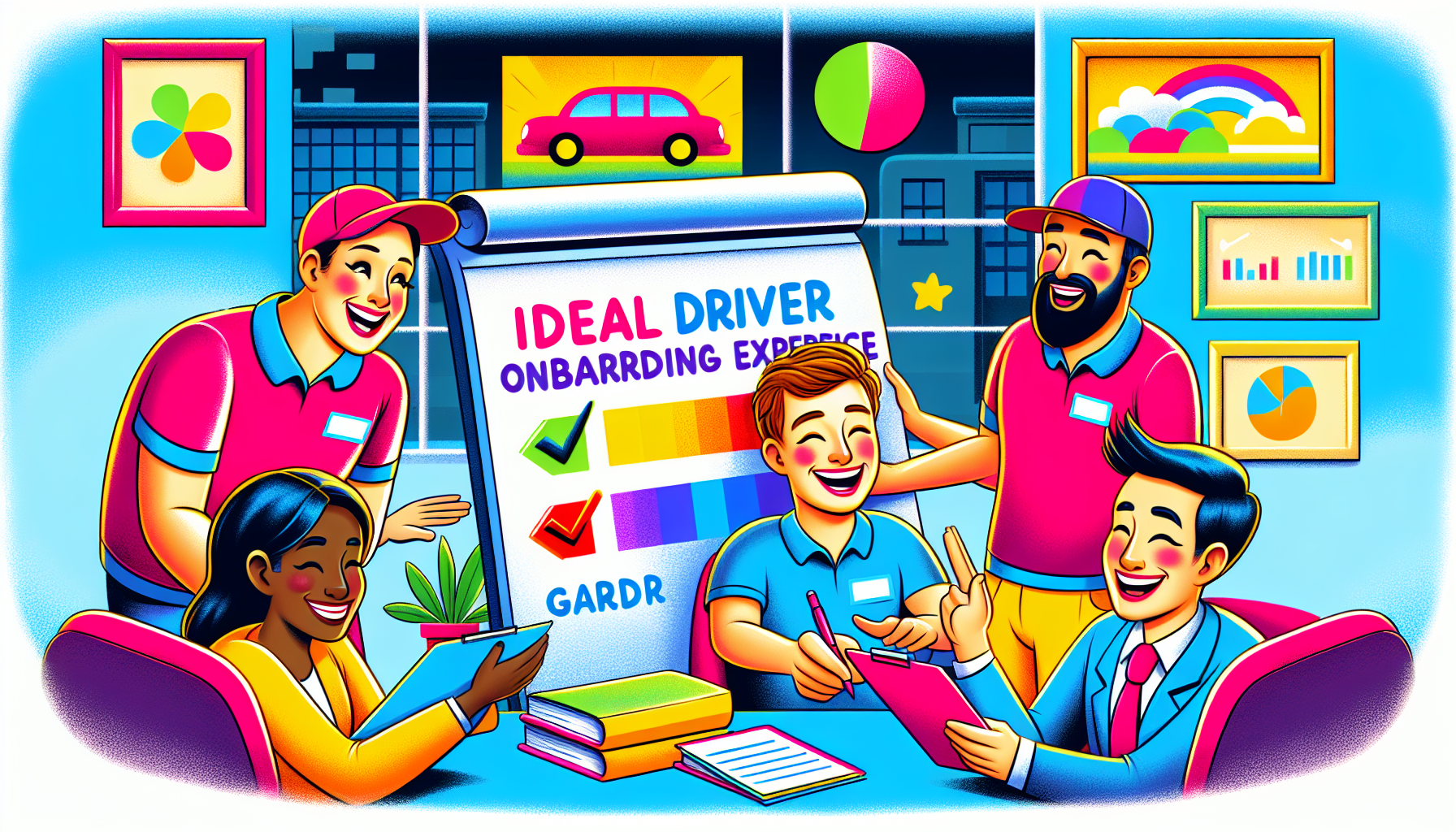
Driver Onboarding: Tips & Best Practices | Zerity
- Mastering the Art of Onboarding Drivers: Top Tips and Best Practices
- Key Takeaways
- Understanding the Importance of Driver Onboarding
- Common Challenges in Driver Onboarding
- Leveraging Technology for Efficient Driver Onboarding
- How Zerity Transforms the Driver Onboarding Process
- Enhancing Driver Engagement and Training
- Creating a Positive Onboarding Culture
- Best Practices for a Smooth Driver Onboarding Experience
- Continuous Improvement and Adaptation
- Summary
- Frequently Asked Questions
- What advantage does Zerity provide for managing the onboarding process?**?
- How does technology streamline the driver onboarding process?**?
- Why is an onboarding checklist important?**?
- How can ongoing training benefit new drivers?**?
- What role does biometric verification play in the onboarding process?**?
Mastering the Art of Onboarding Drivers: Top Tips and Best Practices
Delivery drivers are crucial for any transportation business in the logistics and courier industry, aiming to ensure safe, compliant, and satisfied employees. This article will explain why a structured onboarding process is essential, highlight common challenges, and explore how technology can streamline the process. By the end, you’ll understand best practices and tools that can make onboarding drivers smoother and more efficient.
Key Takeaways
-
A structured onboarding process is essential for driver satisfaction, retention, and compliance in transportation businesses.
-
Driver onboarding involves challenges such as manual paperwork, time-consuming background checks, and inefficient communication, which hinder effective onboarding and must be addressed.
-
Leveraging technology, such as digital document management and automated background checks, enhances the onboarding experience, reduces administrative burdens, and improves overall efficiency.
Understanding the Importance of Driver Onboarding

The implementation of an effective driver onboarding process is essential for the success of any transport-focused business. It extends beyond simply enabling a new driver to start driving, as it prepares them to provide top-notch service with confidence and efficiency. When drivers undergo a thorough orientation process, their job satisfaction increases significantly—this leads in turn not only to satisfied customers, but also contributes positively to the company’s bottom line. To cater to the growing need for skilled drivers, fleet managers and those heading businesses must give due importance to streamlining this crucial aspect.
Incorporating engagement strategies throughout the onboarding experience can have profound impacts on both productivity levels and long-term retention rates among drivers. By employing a comprehensive driver onboarding checklist during this phase, companies can avoid major pitfalls by ensuring all critical procedures are addressed effectively. This method enhances safety standards and adherence policies, which are indispensable in fostering trustworthiness within industry circles while simultaneously heightening overall contentment amongst onboarded personnel.
With competition rife within logistics sectors, having robust processes in place for both driver induction and ongoing support becomes fundamental for maintaining a competitive edge within such dynamic markets.
Common Challenges in Driver Onboarding
The process of driver onboarding, while advantageous, can encounter obstacles that may prolong the duration and deplete resources. The integration of drivers is often impeded by burdensome manual paperwork, protracted background checks, and suboptimal communication.
Acknowledging these hurdles is essential for surmounting them and guaranteeing an uninterrupted onboarding experience for new drivers.
Manual Paperwork and Documentation
Manual paperwork is a notorious bottleneck in driver onboarding. It’s time-consuming and prone to human error, leading to potential delays and compliance issues. Essential documentation like the driver's license, employment history, and application form needs meticulous handling.
In a delivery business, traditional document handling can significantly drain time and resources.
Time-Consuming Background Checks
Ensuring safety and adherence to compliance standards through background checks is imperative for new hires, especially when it involves drivers. Nevertheless, the exhaustive scrutiny of their driving history and previous employment can extend the duration of the onboarding process.
Although these verifications are critical for independent drivers, they tend to be quite burdensome. It’s important to refine this procedure in order to expedite time management and facilitate quicker deployment of new drivers onto the roadways.
Inefficient Communication
Efficient communication is critical to a successful onboarding process. Insufficient support and unclear information for new drivers can result in elevated turnover rates due to ineffective communication channels. The absence of systems capable of real-time tracking and monitoring makes it challenging to gauge driver activity and assess performance indicators.
By bolstering the efficacy of communication, the experience for drivers during onboarding can be markedly improved, which in turn may lead to better retention figures.
Leveraging Technology for Efficient Driver Onboarding

The onboarding process for drivers has been transformed by technological advancements, becoming efficient and swift. Utilization of digital tools and automation can dramatically cut down the amount of administrative work required and expedite the time it takes to onboard new drivers. The ability for drivers to complete their onboarding remotely adds to this convenience, significantly boosting efficiency.
Embracing the latest technologies is essential in ensuring that the driver onboarding process remains both proficient and effective.
Digital Document Management Software
Utilizing digital document management software can be a significant driver of efficiency and cost reduction in the onboarding process. By consolidating driver documentation into a single, accessible location, this technology helps streamline storage and retrieval.
By employing functionalities such as version control, collaborative editing capabilities, and improved security measures within these systems to manage documents effectively eliminates the risk of misplacing crucial paperwork. When integrated with other platforms, these tools have the capacity to automate the completion of documents thereby conserving precious time.
Automated Background Checks
The process of manually verifying background checks for new drivers can lead to protracted delays in their onboarding. By utilizing automated systems that interface with external databases, the verification process is expedited, ensuring that safety protocols are adhered to quickly and compliance is maintained.
Securely housing these verifications within a driver’s profile aids in the effective management of compliance obligations.
Real-Time Tracking and Monitoring
For fleet managers, the onboarding process is crucial as it encompasses real-time tracking and monitoring which are key to regulating driver performance and perfecting route planning. By utilizing real-time data during this phase, they can make decisions that improve both the efficiency of drivers’ routes and their overall productivity. Incorporating these instruments into the driver onboarding routine elevates operational effectiveness and promises an improved experience for dispatchers as well as drivers.
How Zerity Transforms the Driver Onboarding Process

Zerity has revolutionized the onboarding process for drivers by eliminating delays and simplifying processes with digital solutions. The automation of tasks coupled with a decrease in manual mistakes leads to an improved workflow during driver onboarding.
With its adaptable software solutions, firms can swiftly respond to evolving requirements without facing additional costs. This combination of digitization and agility results in an enhanced and more flexible onboarding experience for drivers.
Streamlined Onboarding Workflow
Zerity has created a more efficient and digitized onboarding process for self-employed drivers by combining different elements into an integrated system. This innovation supports companies such as Amazon, DPD, and DHL in efficiently expanding their business activities.
During the onboarding of drivers, users have the ability to oversee, monitor, and advance every stage within one unified interface. This ensures that drivers effortlessly submit all required information and upload any necessary documentation throughout the onboarding procedure.
AI-Powered Document Review
The use of artificial intelligence by Zerity accelerates and improves the precision of document verification. The process, powered by AI, automates the review of critical documents, drastically cutting down on time needed for verification. This expedited method maintains stringent accuracy and adherence to compliance standards.
Integrated Drug and Alcohol Testing
The platform offered by Zerity streamlines the incorporation and monitoring of drug and alcohol screenings as part of the onboarding workflow. Such an integration is pivotal for upholding safety standards and ensuring adherence to compliance regulations within the transportation sector.
By embedding these examinations into the process of onboarding, it becomes more straightforward to oversee and maintain records of compliance activities.
Biometric Verification
The onboarding process for drivers is made more secure through the use of biometric verification to confirm their identities. By implementing this verification on documents, Zerity brings an additional security measure, guaranteeing that only the right person is successfully onboarded.
Employing such technology proves essential in upholding compliance and fostering trust throughout the entire onboarding procedure.
Enhancing Driver Engagement and Training

Effective engagement and comprehensive training programs are essential elements of the driver onboarding process. These strategies can markedly decrease turnover rates among drivers while boosting job satisfaction levels. By ensuring new drivers receive thorough preparation and feel confident in their roles, they’re better equipped for success when they begin driving.
Pre-Onboarding Training Courses
Training courses for pre-onboarding are designed to provide new drivers with the crucial knowledge and abilities they require prior to formally commencing their driving duties. Tailored to align with the specific job responsibilities of the driver and the conditions in which they will be operating, these programs integrate evaluations of potential risks associated with driving.
Zerity delivers this training content, guaranteeing that new drivers are fully prepared as soon as they embark on their roles.
Ongoing Training and Support
Employee onboarding and ongoing support are essential to assist new drivers in acclimating to their job responsibilities. Structured safety training programs not only elevate job satisfaction, but also address the difficulties encountered by commercial truck drivers. Sustained education and assistance guarantee that these drivers maintain both compliance with regulations and assurance in their driving capabilities.
Peer Learning and Mentorship
Peer learning and mentorship programs allow experienced drivers to share their knowledge and experiences with new hires, which helps to retain drivers by creating a welcoming and supportive culture. This approach facilitates a smoother onboarding experience and helps new drivers feel supported and integrated into the company culture.
Incorporating video materials and practical demonstrations further enhances comprehension and retention.
Creating a Positive Onboarding Culture
Creating a positive onboarding culture is crucial for the success of your driver onboarding process. A well-structured onboarding culture can help new drivers feel welcome, valued, and supported, leading to increased driver retention and job satisfaction.
Building a Welcoming Environment
Building a welcoming environment is the first step in creating a positive onboarding culture. This can be achieved by providing a clean and comfortable workspace, introducing new drivers to the team, and ensuring that all necessary equipment and resources are available. Fleet managers can also consider assigning a mentor or buddy to new drivers to provide guidance and support during the onboarding process. This approach not only helps new drivers acclimate more quickly but also fosters a sense of belonging and community within the team.
Encouraging Open Communication
Encouraging open communication is essential for creating a positive onboarding culture. Fleet managers should ensure that new drivers feel comfortable asking questions and seeking help when needed. This can be achieved by providing regular check-ins, offering feedback and coaching, and encouraging open communication throughout the onboarding process. Open communication channels help address any concerns or issues promptly, ensuring that new drivers feel heard and supported.
Recognizing and Rewarding Progress
Recognizing and rewarding progress is a great way to motivate new drivers and reinforce positive behavior. Fleet managers can consider recognizing milestones, such as completing the onboarding process or achieving a certain level of performance. Rewards can include bonuses, extra time off, or recognition at team meetings. By acknowledging the efforts and achievements of new drivers, fleet managers can boost morale and encourage continued excellence.
Best Practices for a Smooth Driver Onboarding Experience

By adopting best practices during the onboarding process, companies can see a considerable decrease in recruitment expenses due to enhanced driver retention and greater levels of engagement among new drivers. Initiating the onboarding phase prior to the arrival of a new driver establishes precise expectations and promotes an inviting atmosphere. Utilizing contemporary onboarding tools offers insights into performance metrics in real-time, which facilitates improved decision-making.
It’s crucial for effective engagement with drivers that training programs be customized to meet their unique requirements and proficiency levels. Providing consistent support alongside periodic refresher sessions and frequent assessments helps uphold superior standards while assuring continued compliance.
Adherence to these recommended procedures has been shown to improve the performance outcomes of newly onboarded drivers by as much as 11%.
Maintaining an Onboarding Checklist
An extensive onboarding checklist is crucial for ensuring that all aspects of the onboarding process are covered, preventing any oversight in critical steps that could impact the driver’s preparedness and adherence to regulations.
It is vital to consistently refresh and scrutinize this checklist to keep pace with evolving policies and the requirements of drivers, and to provide essential documents for future reference.
Simplifying the Toolkit
Implementing comprehensive tools can enhance the onboarding process, simplifying it for those involved in driver management as well as for drivers. Such tools are tailored to be straightforward and user-friendly, even for drivers who may not be highly proficient with technology.
By streamlining the toolkit used during onboarding, both the quality of the onboarding experience is elevated and time efficiency is increased significantly.
Prioritizing Flexibility and Customization
Choosing customizable software solutions ensures specific business requirements are met effectively. Flexible onboarding platforms can cater to diverse operational needs, enhancing overall onboarding effectiveness.
Prioritizing flexibility and customization can streamline the driver onboarding process and improve efficiency.
Continuous Improvement and Adaptation
Continuous improvement and adaptation are essential for ensuring that your driver onboarding process remains effective and efficient. By gathering feedback and insights from new drivers, fleet managers can identify areas for improvement and make necessary changes to the onboarding process.
Gathering Feedback and Insights
Gathering feedback and insights from new drivers is crucial for continuous improvement and adaptation. Fleet managers can use surveys, focus groups, or one-on-one interviews to gather feedback and insights from new drivers. This feedback can be used to identify areas for improvement, such as the need for additional training or support, and make necessary changes to the onboarding process. By actively seeking and acting on feedback, fleet managers can ensure that the onboarding process evolves to meet the changing needs of new drivers and the organization.
By creating a positive onboarding culture and continuously improving and adapting the driver onboarding process, fleet managers can ensure that new drivers feel welcome, valued, and supported, leading to increased driver retention and job satisfaction.
Summary
To excel in the driver onboarding process, it’s critical to recognize its significance, tackle prevalent obstacles head-on, make use of technology advancements, and apply industry best practices. A methodical approach to the onboarding experience can significantly boost a driver’s contentment with their role, their desire to stay with the company long-term, as well as improve operational productivity. Utilizing solutions such as Zerity can revolutionize this process by guaranteeing compliance while simultaneously cutting down both time and resource expenditure. By putting these strategies into practice, companies will cultivate a more committed and efficient driving staff.
Frequently Asked Questions
What advantage does Zerity provide for managing the onboarding process?**?
Zerity enhances the efficiency and oversight of the onboarding process, allowing users to oversee, manage, and advance through every stage within a unified interface.
By centralizing this approach, Zerity makes it easier for managers as well as new hires to navigate the onboarding experience.
How does technology streamline the driver onboarding process?**?
Technology streamlines the driver onboarding process by reducing administrative tasks, automating key processes, and offering real-time data, resulting in a faster and more efficient experience for all parties involved.
Why is an onboarding checklist important?**?
Ensuring that every important step is meticulously followed, an onboarding checklist plays a critical role in reducing the chance of missing any details and confirms that new hires are prepared and compliant.
By adopting this systematic method for onboarding, it facilitates more efficient assimilation of new employees into the company’s environment.
How can ongoing training benefit new drivers?**?
Ongoing training significantly enhances new drivers’ skills, ensuring they stay confident and compliant while adapting effectively to their roles.
This continuous support fosters both professional growth and safety on the road.
What role does biometric verification play in the onboarding process?**?
Biometric verification plays a crucial role in the onboarding process by enhancing security and ensuring that the correct individuals are verified, which helps maintain compliance. This not only protects sensitive information, but also builds trust in the onboarding experience.
